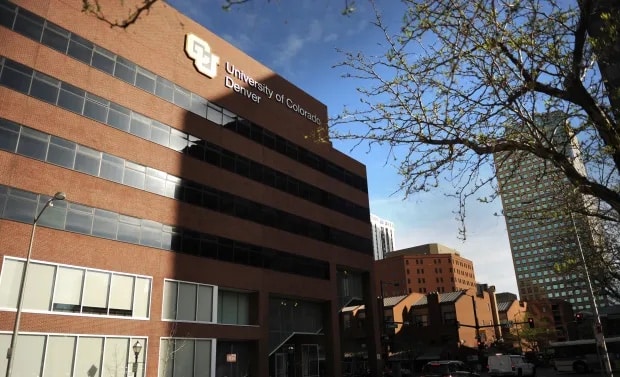
University of Colorado Boulder student Jake Levine throws a tennis ball for his dog Chipper while hanging out on campus with graduate Megan Shoults and her dog Stella. (Timothy Hurst/Daily Camera)
After massive gains in 2020 and early 2021, endowment funds at Colorado universities shed hundreds of millions of dollars in the latest fiscal year.
For most schools in the state, this two-year “roller coaster ride,” in the words of one foundation president, has ultimately left them with more money in their endowment funds. But the volatility has forced at least one to change how it distributes that money to students.
“We had an incredible year, a historic year, in fiscal year 2021,” said Jack Finlaw, president and CEO of the University of Colorado Foundation, referring to the 12 months between mid-2020 and mid-2021. “We had a 37 percent return.”
For several years the value of CU’s endowment added up to about $1.4 billion or $1.5 billion, Finlaw said. Then that 37 percent return sent it soaring to $2.1 billion.
In the year that followed, ending June 30, CU’s endowment lost 6 percent of its value and ended at an even $2 billion, according to public reports.

Student Henry Blackburn arrives on Colorado State’s campus in a mask to follow social distancing guidelines during the coronavirus outbreak. (Brandon Randall/Courtesy of CSU Athletics)
At the Colorado State University Foundation, the endowment was worth $393 million at the end of fiscal year 2020, surged to $558 million in 2021 and slipped 4.7 percent to $532 million in 2022.
“Like most foundations, we strive to perform well in good years, while cushioning our assets in turbulent times, such as those we’re experiencing now,” said CSU Foundation President and CEO Cherí O’Neill. “This strategy worked well for us.”
A similar story played out at the Colorado School of Mines Foundation. The endowment there went from $285 million in 2020 to $397 million in 2021 and then dropped 11 percent to $353 million in 2022.
“While no institution likes to experience losses, we are buoyed by our extraordinary gains in FY21 and our performance of the last 10 and 20 years,” said Rachelle Trujillo, a spokeswoman for the foundation in Golden. “Unlike an individual’s investments that are affected by personal lifetime events like retirement, our investment horizon is infinitely longer.”
At Colorado Mesa University in Grand Junction, the endowment shot up in value from $37.2 million in mid-2020 to $49.4 million by mid-2021, then slid 14.8 percent to $42.1 million this summer.
Several Colorado colleges, including the private University of Denver, declined to release their endowment figures to BusinessDen or be interviewed about them. A DU spokesman said only that “the University of Denver’s endowment remains fiscally healthy.”
Regardless of their losses, some of the state’s largest university foundations have been emboldened by knowledge that they outperformed many peers and markets.
“Despite the chaos and uncertainty in the markets, the CSU Foundation’s one-year return on endowed assets outperformed the market overall,” said O’Neill, the foundation president. “Specifically, while the S&P 500 was down 10.62 percent for our 2022 fiscal year, the one-year return on the CSU Foundation’s endowed assets was down only 3.35 percent.”
The CU Foundation fought off a lawsuit this year that questioned its investment strategy. Finlaw, the foundation president, credits the endowment’s diversification for its mild fluctuations.
“We don’t ride up as quickly with the S&P 500 and we don’t ride down as quickly as it falls,” he said.
It remains to be seen whether endowments will bounce back in fiscal year 2023, which began July 1. CU’s endowment dropped 2 percent between July and September but recovered in October and November. Finlaw hopes they’ll end the calendar year ahead.
“The current global market volatility and countless uncontrollable factors makes it nearly impossible to project short-term performance,” said Trujillo at the Mines Foundation. But, she emphasized, her foundation is focused on long-term rather than short-term gains.
“Despite the expertise on our CSU Foundation team, we too can’t always predict what’s next in this world,” O’Neill added. “However, to ease the roller coaster ride for our beneficiaries at CSU, we moved from payouts based on single-year performance to payouts based on a three-year rolling average.” So, losses in fiscal year 2022 didn’t shrink payouts.
“We’re running a marathon, not a sprint,” O’Neill said, “and we’re confident that this tried-and-true long-term strategy will continue to produce favorable results.”

University of Colorado Boulder student Jake Levine throws a tennis ball for his dog Chipper while hanging out on campus with graduate Megan Shoults and her dog Stella. (Timothy Hurst/Daily Camera)
After massive gains in 2020 and early 2021, endowment funds at Colorado universities shed hundreds of millions of dollars in the latest fiscal year.
For most schools in the state, this two-year “roller coaster ride,” in the words of one foundation president, has ultimately left them with more money in their endowment funds. But the volatility has forced at least one to change how it distributes that money to students.
“We had an incredible year, a historic year, in fiscal year 2021,” said Jack Finlaw, president and CEO of the University of Colorado Foundation, referring to the 12 months between mid-2020 and mid-2021. “We had a 37 percent return.”
For several years the value of CU’s endowment added up to about $1.4 billion or $1.5 billion, Finlaw said. Then that 37 percent return sent it soaring to $2.1 billion.
In the year that followed, ending June 30, CU’s endowment lost 6 percent of its value and ended at an even $2 billion, according to public reports.

Student Henry Blackburn arrives on Colorado State’s campus in a mask to follow social distancing guidelines during the coronavirus outbreak. (Brandon Randall/Courtesy of CSU Athletics)
At the Colorado State University Foundation, the endowment was worth $393 million at the end of fiscal year 2020, surged to $558 million in 2021 and slipped 4.7 percent to $532 million in 2022.
“Like most foundations, we strive to perform well in good years, while cushioning our assets in turbulent times, such as those we’re experiencing now,” said CSU Foundation President and CEO Cherí O’Neill. “This strategy worked well for us.”
A similar story played out at the Colorado School of Mines Foundation. The endowment there went from $285 million in 2020 to $397 million in 2021 and then dropped 11 percent to $353 million in 2022.
“While no institution likes to experience losses, we are buoyed by our extraordinary gains in FY21 and our performance of the last 10 and 20 years,” said Rachelle Trujillo, a spokeswoman for the foundation in Golden. “Unlike an individual’s investments that are affected by personal lifetime events like retirement, our investment horizon is infinitely longer.”
At Colorado Mesa University in Grand Junction, the endowment shot up in value from $37.2 million in mid-2020 to $49.4 million by mid-2021, then slid 14.8 percent to $42.1 million this summer.
Several Colorado colleges, including the private University of Denver, declined to release their endowment figures to BusinessDen or be interviewed about them. A DU spokesman said only that “the University of Denver’s endowment remains fiscally healthy.”
Regardless of their losses, some of the state’s largest university foundations have been emboldened by knowledge that they outperformed many peers and markets.
“Despite the chaos and uncertainty in the markets, the CSU Foundation’s one-year return on endowed assets outperformed the market overall,” said O’Neill, the foundation president. “Specifically, while the S&P 500 was down 10.62 percent for our 2022 fiscal year, the one-year return on the CSU Foundation’s endowed assets was down only 3.35 percent.”
The CU Foundation fought off a lawsuit this year that questioned its investment strategy. Finlaw, the foundation president, credits the endowment’s diversification for its mild fluctuations.
“We don’t ride up as quickly with the S&P 500 and we don’t ride down as quickly as it falls,” he said.
It remains to be seen whether endowments will bounce back in fiscal year 2023, which began July 1. CU’s endowment dropped 2 percent between July and September but recovered in October and November. Finlaw hopes they’ll end the calendar year ahead.
“The current global market volatility and countless uncontrollable factors makes it nearly impossible to project short-term performance,” said Trujillo at the Mines Foundation. But, she emphasized, her foundation is focused on long-term rather than short-term gains.
“Despite the expertise on our CSU Foundation team, we too can’t always predict what’s next in this world,” O’Neill added. “However, to ease the roller coaster ride for our beneficiaries at CSU, we moved from payouts based on single-year performance to payouts based on a three-year rolling average.” So, losses in fiscal year 2022 didn’t shrink payouts.
“We’re running a marathon, not a sprint,” O’Neill said, “and we’re confident that this tried-and-true long-term strategy will continue to produce favorable results.”


